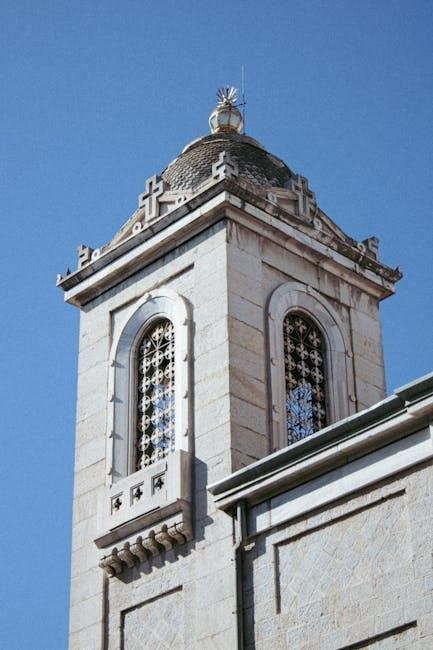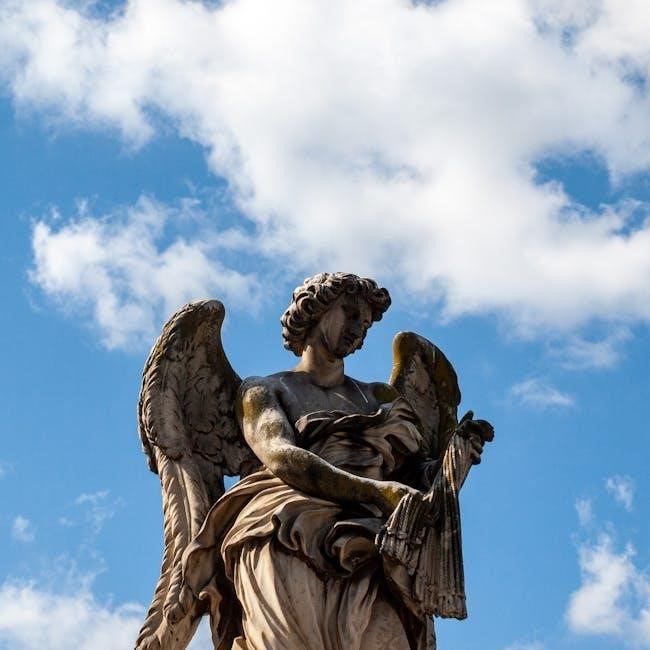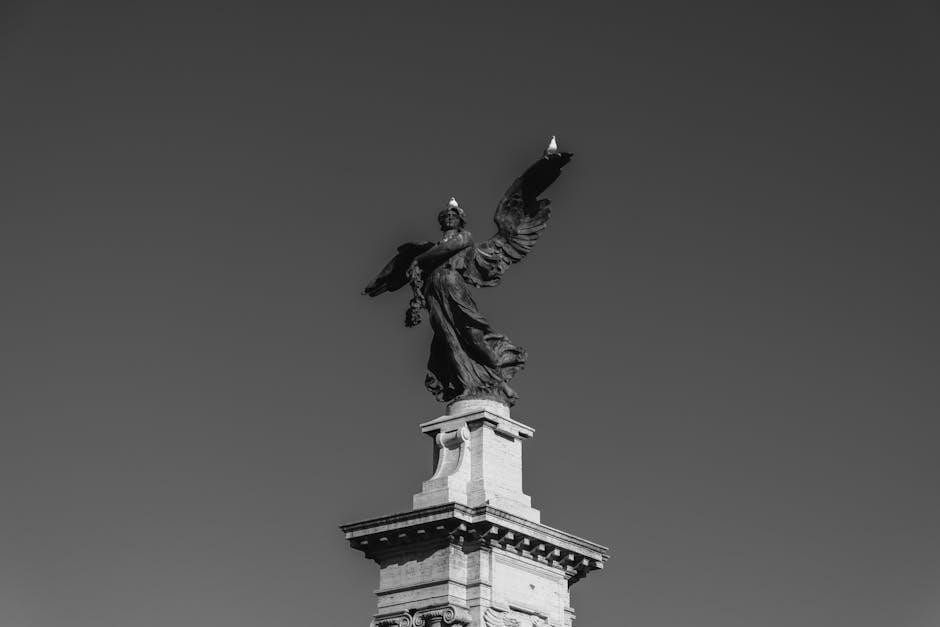The traditional Basque carol‚ “The Angel Gabriel from Heaven Came‚” reflects the Annunciation story‚ with its PDF resource offering sheet music and lyrics․ Sabine Baring-Gould translated it‚ blending theological depth with cultural heritage‚ making it a cherished Christmas hymn․
1․1 Historical Background of the Carol
The carol “The Angel Gabriel from Heaven Came” originates from a traditional Basque Christmas song‚ reflecting the biblical account of the Annunciation․ Its lyrics‚ translated by Sabine Baring-Gould in the 19th century‚ capture the moment when Gabriel announces to Mary that she will bear Jesus․ The carol’s melody and text have been preserved and adapted over centuries‚ blending cultural and religious heritage․ Its historical roots in Basque tradition and its biblical inspiration make it a timeless piece‚ cherished in Christmas celebrations worldwide․ The PDF resource provides access to its sheet music‚ ensuring its legacy endures for modern worship and education․
1․2 Cultural Significance of the Angel Gabriel
The Angel Gabriel holds profound cultural and spiritual significance‚ often depicted as a divine messenger in religious and artistic traditions․ In the carol‚ Gabriel’s imagery—wings like drifted snow and eyes like flame—symbolizes purity and divine authority․ His role in the Annunciation‚ as celebrated in the carol‚ underscores his importance in Christian theology․ Sabine Baring-Gould’s translation of the Basque carol has further popularized Gabriel’s story‚ bridging cultural and linguistic gaps․ The carol’s enduring presence in Christmas traditions highlights Gabriel’s universal appeal‚ making him a cherished figure in both religious and cultural contexts․ The PDF resource preserves this legacy‚ ensuring its accessibility for future generations․
1․3 Overview of the PDF Resource
The PDF resource for “The Angel Gabriel from Heaven Came” offers a comprehensive guide to the traditional Basque carol․ It includes sheet music‚ lyrics‚ and detailed information about the melody and its historical background․ The resource is designed for both worship and educational purposes‚ making it accessible to congregations and scholars alike․ Available for free download‚ the PDF features the original Basque text‚ Sabine Baring-Gould’s translation‚ and musical arrangements․ It also provides insights into the carol’s cultural significance and theological themes․ This resource is widely used in Christmas celebrations and serves as a valuable tool for understanding the carol’s enduring legacy․

The Angel Gabriel in Religious Texts
The Angel Gabriel is prominently featured in religious texts‚ notably the Bible‚ as a divine messenger․ His role in the Annunciation and other scriptural accounts underscores his significance․
2․1 Biblical Accounts of the Angel Gabriel
The Angel Gabriel is a prominent figure in biblical narratives‚ notably in the Annunciation to the Virgin Mary (Luke 1:26-38)․ He appears as a divine messenger‚ delivering God’s will with clarity and authority․ In Daniel 8:15-27 and 9:20-27‚ Gabriel interprets visions‚ showcasing his role as a revealer of divine truths․ His appearances emphasize his unique position among angels‚ often highlighting his celestial beauty and intimidating presence․ The carol reflects these accounts‚ portraying Gabriel with “wings as drifted snow” and “eyes as flame‚” symbolizing purity and divine power․ The PDF resource includes these scriptural references‚ enriching the carol’s theological depth․
2․2 The Role of Gabriel in the Annunciation
Gabriel plays a central role in the Annunciation‚ delivering God’s message to Mary about her divine pregnancy (Luke 1:26-38)․ The carol vividly depicts his appearance: “His wings as drifted snow‚ his eyes as flame‚” symbolizing purity and divine authority․ Gabriel’s greeting‚ “All hail‚ thou lowly maiden Mary‚” underscores Mary’s favored status․ His message announces the coming of Emmanuel‚ emphasizing redemption and hope․ The PDF resource highlights this biblical event‚ linking the carol’s lyrics to scripture‚ and showcasing Gabriel’s role as a divine messenger․ This narrative is foundational to Christian theology‚ celebrating God’s plan through Gabriel’s words․

2․3 Gabriel in Other Religious Traditions
Gabriel is revered in various religious traditions beyond Christianity․ In Islam‚ he is known as Jibril‚ the holy spirit who revealed the Quran to Prophet Muhammad․ Jewish tradition also recognizes Gabriel as an archangel‚ often associated with divine judgment and fire․ Some religious texts describe Gabriel as a destroyer of wickedness‚ as seen in the annihilation of Sodom and Gomorrah․ Across these traditions‚ Gabriel consistently appears as a powerful messenger of God‚ emphasizing his role in delivering divine will․ The PDF resource highlights these cross-religious depictions‚ showcasing Gabriel’s universal significance as a celestial envoy and symbol of divine authority․
The Lyrics and Their Meaning
The lyrics of “The Angel Gabriel from Heaven Came” vividly depict Gabriel’s divine appearance and Mary’s humble acceptance․ Rich in poetic imagery‚ the carol reflects themes of faith‚ hope‚ and divine favor‚ celebrating the Virgin Mary as a blessed mother․
3․1 The Poetic Structure of the Carol
The carol follows a traditional poetic structure with a meter of 10 10 12 10‚ creating a lyrical and rhythmic flow․ The verses are rich in imagery‚ such as Gabriel’s wings “as drifted snow” and eyes “as flame‚” which evoke a sense of divine presence․ The poetic devices‚ including metaphor and simile‚ enhance the narrative‚ while the repetition of phrases like “Most highly favoured lady‚ Gloria!” emphasizes theological themes․ The structure supports the musical adaptation‚ blending poetic beauty with spiritual depth‚ making it a timeless hymn for worship and reflection․
3․2 Symbolism in the Lyrics
The lyrics of “The Angel Gabriel from Heaven Came” are rich in symbolism‚ with imagery such as Gabriel’s wings “as drifted snow” and eyes “as flame‚” representing purity and divine presence․ Mary is portrayed as a “lowly maiden‚” emphasizing humility‚ while her title as “most highly favoured lady” signifies divine favor․ The references to Emmanuel and the hope of generations underscore redemption and messianic promise․ These symbols weave together to convey the sacredness of the Annunciation and the profound spiritual significance of Mary’s role in salvation history‚ creating a vivid and meaningful narrative․
3․3 Theological Themes in the Song
The song explores profound theological themes‚ including divine favor‚ incarnation‚ and redemption․ Gabriel’s announcement to Mary highlights God’s sovereign grace‚ emphasizing her role as the chosen vessel for the Messiah․ The lyrics underscore the virgin birth and the fulfillment of prophecy‚ reflecting on Emmanuel as a symbol of hope and salvation․ The interaction between Gabriel and Mary also illustrates the humility required to receive divine revelation․ These themes‚ rooted in biblical accounts‚ offer a rich theological narrative‚ making the carol a meaningful expression of Christian doctrine and the mystery of the Incarnation․

The Basque Origin of the Carol
The carol originates from the Basque region‚ reflecting rich cultural heritage․ Its traditional melody and lyrics‚ translated by Sabine Baring-Gould‚ highlight its enduring popularity as a Christmas hymn․
4․1 Traditional Basque Music and Its Influence
The carol‚ “The Angel Gabriel from Heaven Came‚” is a traditional Basque Christmas folk song‚ reflecting the rich cultural and musical heritage of the Basque region․ Its haunting melody‚ passed down through generations‚ captures the essence of Basque musical traditions․ The song’s structure‚ with its 10 10 12 10 meter‚ underscores its origins in regional folk music․ Sabine Baring-Gould’s translation introduced it to a broader audience‚ blending Basque spirituality with universal Christian themes․ The carol’s enduring popularity highlights the profound influence of Basque music on global Christmas traditions‚ preserving its cultural identity while resonating with diverse audiences․
4․2 The Role of Sabine Baring-Gould in Popularizing the Carol
Sabine Baring-Gould‚ a renowned scholar‚ hymnologist‚ and novelist‚ played a pivotal role in popularizing “The Angel Gabriel from Heaven Came․” He translated the traditional Basque carol into English‚ preserving its cultural essence while making it accessible to a broader audience․ His work not only introduced the carol to English-speaking communities but also ensured its inclusion in hymnals and Christmas services worldwide․ Baring-Gould’s efforts helped bridge cultural gaps‚ allowing the carol to resonate with diverse audiences while maintaining its original religious and historical significance․
4․3 Cultural Significance in Basque Heritage
“The Angel Gabriel from Heaven Came” holds profound cultural significance in Basque heritage‚ reflecting the region’s deep-rooted Christian traditions and musical richness․ As a traditional Basque carol‚ it embodies the community’s spiritual identity and artistic expression․ The carol’s melody and lyrics‚ passed down through generations‚ are cherished in local celebrations and worship services․ Its adaptation into various languages‚ including English‚ has broadened its reach while preserving its Basque origins․ This carol remains a testament to the Basque people’s enduring faith and cultural pride‚ resonating as a beloved hymn during Christmas and Advent․
Musical Arrangements and Variations
The carol features a traditional Basque melody with distinctive harmonies․ Modern adaptations include instrumental arrangements for brass‚ choir‚ and solo performances‚ enriching its musical diversity․
5․1 The Traditional Melody and Its Characteristics
The traditional Basque melody of “The Angel Gabriel” is known for its haunting harmony and steady tempo‚ creating a solemn yet uplifting atmosphere․ The tune‚ passed down through generations‚ features a distinctive modal structure that complements the carol’s theological themes․ Its harmonies are simple yet profound‚ supporting the lyrical narrative of the Annunciation․ The melody’s timeless quality has allowed it to remain a cornerstone of Christmas traditions‚ blending seamlessly with various vocal and instrumental arrangements while retaining its original charm and spiritual depth․
5․2 Modern Adaptations and Instrumental Arrangements
Modern adaptations of “The Angel Gabriel” have breathed new life into the traditional melody‚ with instrumental arrangements ranging from brass ensembles to orchestral performances․ The carol’s haunting harmony is often preserved while incorporating contemporary elements‚ such as electronic beats or jazz improvisations․ Many arrangements feature piano or guitar accompaniments‚ making the piece accessible for diverse musical settings․ A cappella versions highlight the melody’s ethereal quality‚ while instrumental solos‚ like flute or violin‚ emphasize its emotional depth․ These adaptations ensure the carol remains relevant‚ blending its timeless message with fresh musical interpretations․ Its versatility continues to captivate audiences across genres and generations․
5․3 The Carol in Different Musical Genres
“The Angel Gabriel from Heaven Came” has transcended traditional boundaries‚ finding expression across various musical genres․ Jazz‚ rock‚ and orchestral arrangements reimagine the carol with vibrant energy‚ while classical ensembles preserve its haunting beauty․ Its melody is particularly suited for a cappella performances‚ emphasizing harmonies and emotional depth․ Instrumental solos‚ such as flute or violin‚ highlight its ethereal quality‚ while brass bands add a celebratory tone․ The carol’s versatility allows it to resonate in diverse musical contexts‚ appealing to audiences of all ages and cultural backgrounds․ Its timeless message blends seamlessly with modern interpretations‚ ensuring its enduring appeal․

The PDF as a Resource
The PDF resource provides sheet music‚ lyrics‚ and arrangements for “The Angel Gabriel from Heaven Came‚” ideal for worship‚ education‚ and personal use‚ ensuring accessibility and versatility․
6․1 Content and Structure of the PDF
The PDF resource for “The Angel Gabriel from Heaven Came” includes sheet music‚ MIDI files‚ and lyrics‚ providing a comprehensive guide for musicians․ It features the traditional Basque melody‚ translated by Sabine Baring-Gould‚ with a 10 10 12 10 meter․ The content is structured to include musical notation for soprano‚ alto‚ tenor‚ and bass‚ along with instrumental arrangements․ Scripture references and liturgical year associations are also highlighted‚ making it a valuable tool for worship and education․ The PDF is designed for accessibility‚ ensuring clarity and usability for diverse musical settings․
6․2 Uses of the PDF in Worship and Education
The PDF of “The Angel Gabriel from Heaven Came” is a versatile resource for worship and education․ It provides sheet music and lyrics‚ enabling choirs and congregations to perform the carol during Advent and Christmas services․ Music directors can use the MIDI files for rehearsal accompaniment‚ while educators can incorporate the PDF into religious or music classes to teach about traditional carols and their theological significance․ The structured format allows for easy adaptation across different worship styles and educational settings‚ making it a valuable tool for fostering spiritual reflection and musical understanding․
6․3 Availability and Access to the PDF
The PDF of “The Angel Gabriel from Heaven Came” is widely available online‚ with free downloads offered by platforms like the Open Hymnal Project and other religious music archives․ Many websites provide both PDF and MIDI formats‚ allowing users to access sheet music and instrumental accompaniments․ Copyright permissions‚ such as those granted to members of the Association of Lutheran Church Musicians‚ ensure legal and convenient access for worship and educational purposes․ This accessibility makes the carol a practical resource for churches‚ schools‚ and individuals seeking to incorporate it into their spiritual or musical practices․

The Role of Angels in Religious Contexts
Angels are divine messengers‚ embodying God’s will‚ often appearing in pivotal biblical events․ Their power and wisdom inspire reverence‚ as seen in Gabriel’s role in the Annunciation․
7․1 The Hierarchy of Angels in Religious Beliefs
In religious traditions‚ angels are often organized into a hierarchical structure‚ reflecting their roles and proximity to the divine․ Archangels‚ such as Michael and Gabriel‚ hold prominent positions‚ with Michael often depicted as a leader in spiritual battles․ Seraphs are described as high-ranking angels stationed near God’s throne‚ emphasizing their sacred duties․ This hierarchy underscores the diverse responsibilities of angels‚ from messengers like Gabriel to protectors and worshippers‚ illustrating a complex celestial order that aligns with theological teachings and biblical accounts․ The structure highlights their significance in fulfilling divine will across various religious narratives․
7․2 The Significance of Gabriel Among Other Angels
Gabriel holds a unique position among angels‚ primarily as a divine messenger․ His prominence is evident in biblical narratives‚ such as the Annunciation to Mary‚ where he delivers God’s message of Jesus’ birth․ Unlike other angels‚ Gabriel is often depicted with vivid imagery‚ such as wings like drifted snow and eyes like flame‚ emphasizing his celestial majesty․ His role in the carol “The Angel Gabriel from Heaven Came” further highlights his significance‚ blending theological and cultural reverence․ Gabriel’s distinct responsibilities and appearances in religious texts set him apart‚ making him a central figure in both liturgical and musical traditions celebrating divine annunciations․
7․3 Angels as Messengers of Divine Will

Angels‚ like Gabriel‚ serve as messengers of God’s will‚ conveying divine plans to humanity․ In the carol‚ Gabriel’s role in the Annunciation underscores his duty to deliver pivotal messages‚ such as the birth of Jesus․ His depiction with wings like snow and eyes like flame symbolizes his divine authority․ The PDF resource highlights how angels execute God’s commands‚ whether halting sacrifices or guiding prophets‚ emphasizing their obedience and power․ This role is central to religious narratives‚ illustrating how angels bridge the heavenly and earthly realms to fulfill divine purposes‚ as seen in Gabriel’s mission to Mary‚ a moment of profound theological significance․

The Carol’s Place in Christmas Traditions
The carol is a cherished part of Christmas traditions‚ featured in Advent services and Nativity plays‚ celebrating the Annunciation with its rich cultural and spiritual significance․
8․1 The Carol in Advent and Christmas Services
“The Angel Gabriel from Heaven Came” is a beloved hymn in Advent and Christmas services‚ reflecting the Annunciation story․ Its traditional Basque melody‚ translated by Sabine Baring-Gould‚ emphasizes Mary’s divine calling․ The carol’s PDF resource provides sheet music and lyrics‚ aiding worship leaders in incorporating it into liturgical celebrations․ It resonates during Advent‚ symbolizing hope and preparation for Christ’s birth‚ while its theological themes deepen the spiritual experience of the season․ This carol bridges cultural heritage with religious devotion‚ making it a timeless element in Christmas traditions worldwide․
8․2 The Carol’s Role in Nativity Plays and Pageants
“The Angel Gabriel from Heaven Came” is often featured in Nativity plays and pageants‚ depicting the Annunciation scene․ Its vivid imagery of Gabriel’s appearance and Mary’s response brings the biblical narrative to life․ The carol’s traditional melody and theological lyrics make it a powerful tool for dramatizing the Christmas story․ Churches and schools use the PDF resource to incorporate the hymn into performances‚ enhancing the spiritual and cultural experience․ This carol bridges worship and theater‚ offering a meaningful way to share the message of Advent and Christmas with diverse audiences․
8․3 The Carol’s Influence on Holiday Music
“The Angel Gabriel from Heaven Came” has significantly influenced holiday music‚ blending traditional Basque melodies with rich theological themes․ Its hauntingly beautiful tune and poetic lyrics have inspired countless adaptations‚ from classical arrangements to modern instrumental renditions․ The carol’s adaptability across genres has made it a staple in Christmas playlists․ Sabine Baring-Gould’s translation further popularized it‚ ensuring its place in global holiday traditions․ The PDF resource provides sheet music for various instruments‚ fostering its use in both sacred and secular settings․ Its enduring appeal continues to inspire new interpretations‚ enriching the musical landscape of Christmas celebrations worldwide․

The Carol’s Message and Spiritual Impact
The carol reflects the Annunciation‚ emphasizing Mary’s pivotal role and divine favor․ Its themes of hope‚ redemption‚ and faith resonate deeply‚ connecting listeners to the Christmas story’s spiritual core․
9․1 The Carol as a Reflection of Faith
The carol profoundly reflects faith through its depiction of the Annunciation‚ highlighting Mary’s humble acceptance of divine will․ Sabine Baring-Gould’s translation emphasizes Mary’s role as a favored servant of God‚ reinforcing themes of trust and obedience; The lyrics‚ rich in theological imagery‚ portray Gabriel as a messenger of God’s plan‚ underscoring the miraculous nature of the Incarnation․ This carol is not merely a song but a spiritual reflection‚ inviting listeners to contemplate the depth of faith required for Mary’s response․ It serves as a powerful reminder of the central tenets of Christian belief‚ connecting worshippers with the divine promise of redemption․
9․2 The Carol’s Message of Hope and Redemption
The carol conveys a powerful message of hope and redemption through Gabriel’s announcement to Mary․ The lyrics emphasize Emmanuel’s coming‚ symbolizing hope for humanity’s salvation․ The imagery of Gabriel’s wings as snow and eyes as flame underscores divine purity and the transformative power of God’s message․ This carol inspires believers to reflect on the promise of redemption through Christ’s birth‚ offering comfort and renewal․ Its timeless message resonates during Advent‚ reminding listeners of the hope embedded in the Incarnation and the ultimate redemption it signifies․
9․3 The Carol’s Influence on Personal Devotion

The carol deeply impacts personal devotion by inviting reflection on Mary’s faith and the divine promise of Emmanuel․ Its lyrics‚ rich in theological imagery‚ inspire prayer and meditation‚ fostering a personal connection to the Annunciation story․ The carol’s message of hope and redemption encourages individuals to embrace God’s plan in their lives․ The availability of the carol in PDF format makes it accessible for personal worship‚ enabling believers to incorporate its meaningful lyrics and melody into private devotions‚ enriching their spiritual journey and deepening their faith during Advent and beyond․
The carol‚ “The Angel Gabriel from Heaven Came‚” remains a timeless expression of faith‚ blending Basque tradition with Christian theology‚ its PDF resource preserving its legacy for worship and reflection․
10․1 Summary of Key Points
The carol‚ “The Angel Gabriel from Heaven Came‚” is a traditional Basque hymn translated by Sabine Baring-Gould‚ capturing the Annunciation’s essence․ Its PDF resource provides sheet music and lyrics‚ making it accessible for worship and educational purposes․ The song blends rich cultural heritage with theological themes‚ emphasizing Mary’s divine favor and Emmanuel’s promise․ Its enduring popularity stems from its poetic structure‚ symbolic imagery‚ and spiritual depth‚ resonating across generations and cultures․ The carol remains a cherished part of Christmas traditions‚ reflecting faith‚ hope‚ and redemption through its timeless message․
10․2 The Enduring Legacy of the Carol
“The Angel Gabriel from Heaven Came” has left an indelible mark on Christmas traditions worldwide․ Its timeless melody and profound lyrics‚ translated by Sabine Baring-Gould‚ continue to inspire faith and reflection․ The carol’s Basque origins and rich cultural heritage have been preserved through its widespread adaptation into various languages and musical arrangements․ Its message of divine favor and redemption resonates deeply‚ making it a cherished hymn in worship and personal devotion․ The PDF resource ensures its legacy endures‚ providing accessible sheet music for generations to celebrate the Annunciation’s spiritual significance․
10․3 Final Thoughts on the Angel Gabriel’s Message
The Angel Gabriel’s message‚ as portrayed in the carol‚ embodies divine favor and redemption․ It captures the essence of faith‚ humility‚ and the miraculous‚ resonating deeply with believers․ The carol’s enduring appeal lies in its ability to bridge cultural and theological traditions‚ offering a timeless reflection on God’s grace․ Mary’s response to Gabriel symbolizes surrender to divine will‚ inspiring devotion and hope․ The carol’s legacy‚ preserved through its PDF resource‚ continues to enrich spiritual practices‚ reminding us of the transformative power of faith and the promise of Emmanuel․
